Nursing Care Plan for Myocardial Infarction Patient
VerifiedAdded on 2023/04/24
|13
|2234
|267
AI Summary
Get a nursing care plan for a patient with myocardial infarction. Learn about the symptoms, diagnosis, and treatment of the disease. Desklib offers solved assignments, essays, dissertations, and more.
Contribute Materials
Your contribution can guide someone’s learning journey. Share your
documents today.
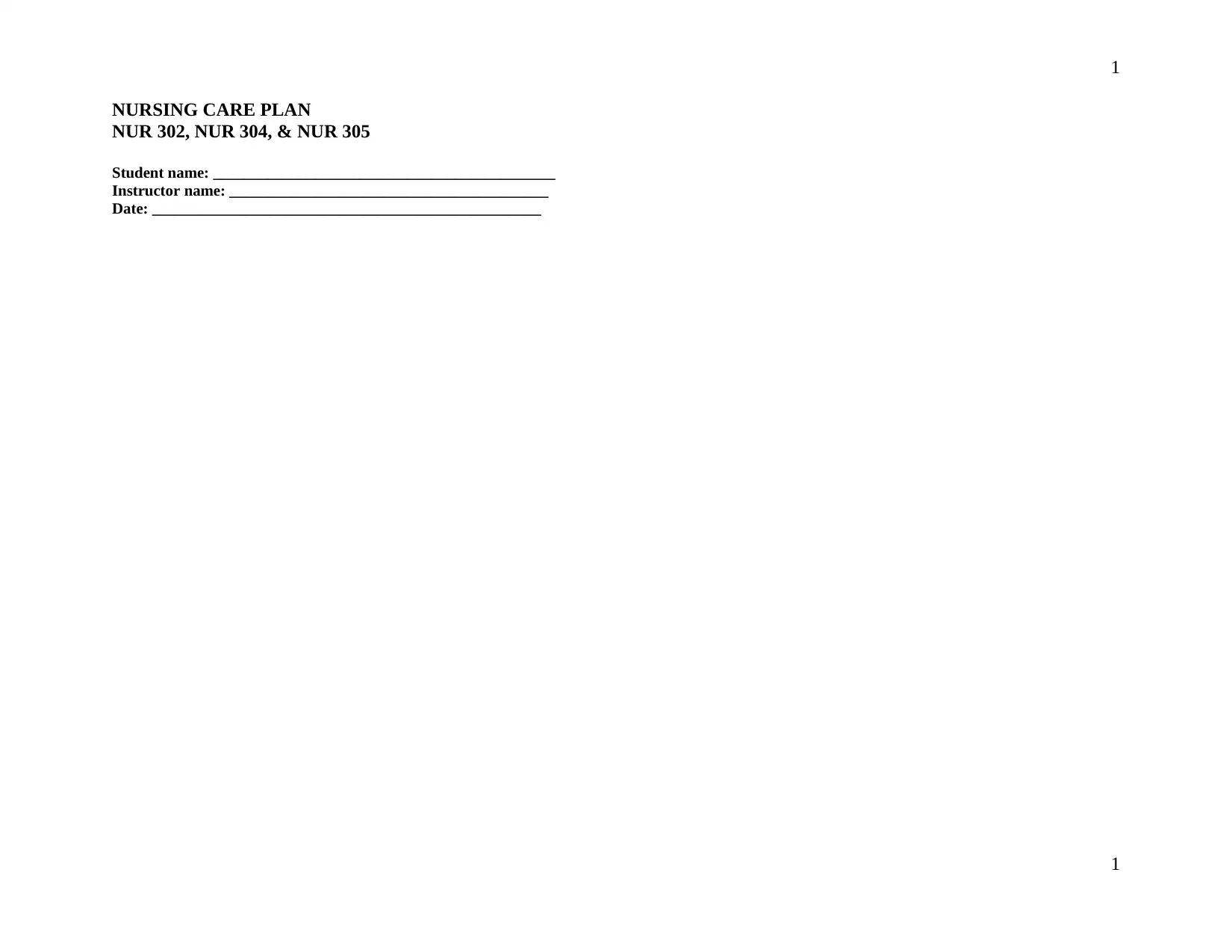
1
NURSING CARE PLAN
NUR 302, NUR 304, & NUR 305
Student name: ____________________________________________
Instructor name: _________________________________________
Date: __________________________________________________
1
NURSING CARE PLAN
NUR 302, NUR 304, & NUR 305
Student name: ____________________________________________
Instructor name: _________________________________________
Date: __________________________________________________
1
Secure Best Marks with AI Grader
Need help grading? Try our AI Grader for instant feedback on your assignments.
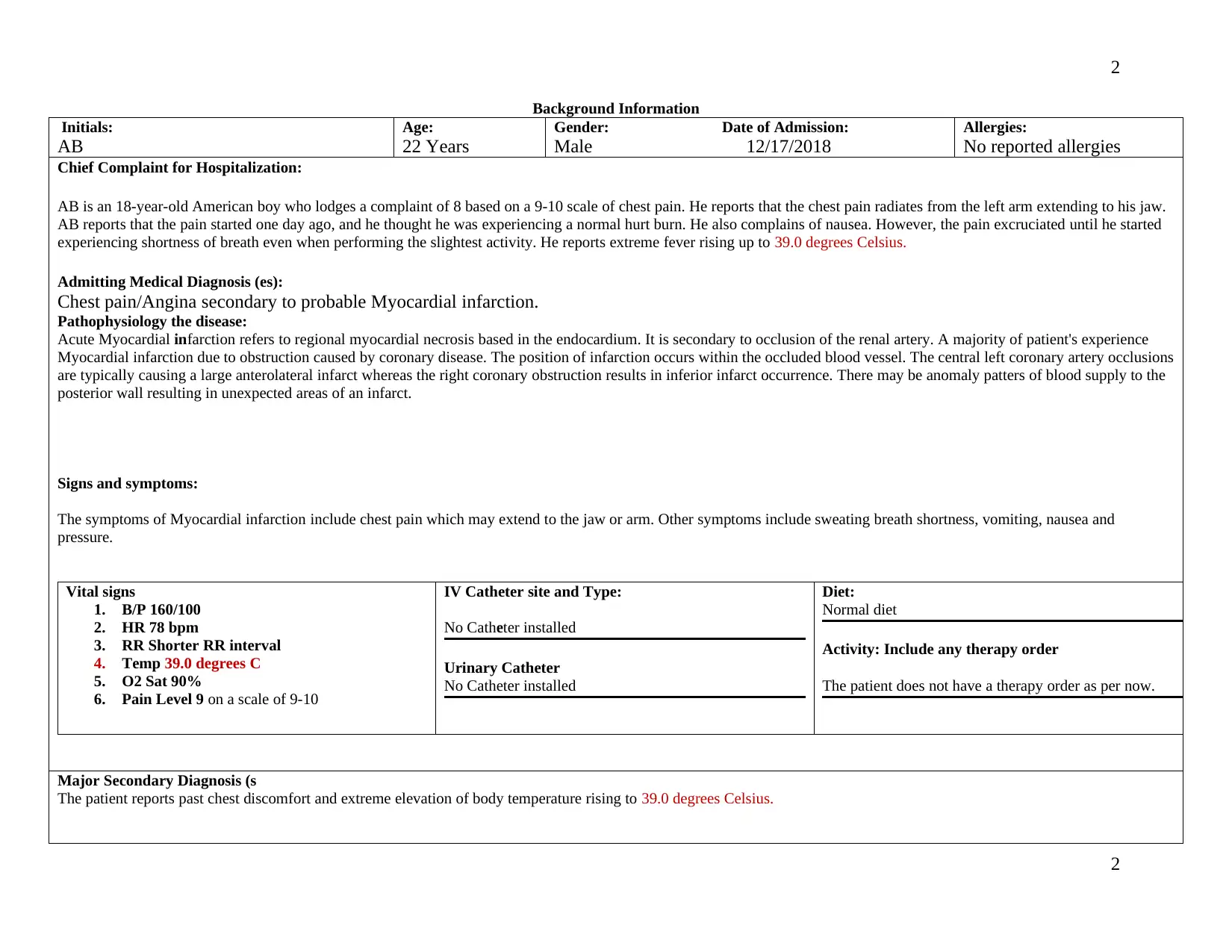
2
Background Information
Initials:
AB
Age:
22 Years
Gender: Date of Admission:
Male 12/17/2018
Allergies:
No reported allergies
Chief Complaint for Hospitalization:
AB is an 18-year-old American boy who lodges a complaint of 8 based on a 9-10 scale of chest pain. He reports that the chest pain radiates from the left arm extending to his jaw.
AB reports that the pain started one day ago, and he thought he was experiencing a normal hurt burn. He also complains of nausea. However, the pain excruciated until he started
experiencing shortness of breath even when performing the slightest activity. He reports extreme fever rising up to 39.0 degrees Celsius.
Admitting Medical Diagnosis (es):
Chest pain/Angina secondary to probable Myocardial infarction.
Pathophysiology the disease:
Acute Myocardial infarction refers to regional myocardial necrosis based in the endocardium. It is secondary to occlusion of the renal artery. A majority of patient's experience
Myocardial infarction due to obstruction caused by coronary disease. The position of infarction occurs within the occluded blood vessel. The central left coronary artery occlusions
are typically causing a large anterolateral infarct whereas the right coronary obstruction results in inferior infarct occurrence. There may be anomaly patters of blood supply to the
posterior wall resulting in unexpected areas of an infarct.
Signs and symptoms:
The symptoms of Myocardial infarction include chest pain which may extend to the jaw or arm. Other symptoms include sweating breath shortness, vomiting, nausea and
pressure.
Vital signs
1. B/P 160/100
2. HR 78 bpm
3. RR Shorter RR interval
4. Temp 39.0 degrees C
5. O2 Sat 90%
6. Pain Level 9 on a scale of 9-10
IV Catheter site and Type:
No Catheter installed
Urinary Catheter
No Catheter installed
Diet:
Normal diet
Activity: Include any therapy order
The patient does not have a therapy order as per now.
Major Secondary Diagnosis (s
The patient reports past chest discomfort and extreme elevation of body temperature rising to 39.0 degrees Celsius.
2
Background Information
Initials:
AB
Age:
22 Years
Gender: Date of Admission:
Male 12/17/2018
Allergies:
No reported allergies
Chief Complaint for Hospitalization:
AB is an 18-year-old American boy who lodges a complaint of 8 based on a 9-10 scale of chest pain. He reports that the chest pain radiates from the left arm extending to his jaw.
AB reports that the pain started one day ago, and he thought he was experiencing a normal hurt burn. He also complains of nausea. However, the pain excruciated until he started
experiencing shortness of breath even when performing the slightest activity. He reports extreme fever rising up to 39.0 degrees Celsius.
Admitting Medical Diagnosis (es):
Chest pain/Angina secondary to probable Myocardial infarction.
Pathophysiology the disease:
Acute Myocardial infarction refers to regional myocardial necrosis based in the endocardium. It is secondary to occlusion of the renal artery. A majority of patient's experience
Myocardial infarction due to obstruction caused by coronary disease. The position of infarction occurs within the occluded blood vessel. The central left coronary artery occlusions
are typically causing a large anterolateral infarct whereas the right coronary obstruction results in inferior infarct occurrence. There may be anomaly patters of blood supply to the
posterior wall resulting in unexpected areas of an infarct.
Signs and symptoms:
The symptoms of Myocardial infarction include chest pain which may extend to the jaw or arm. Other symptoms include sweating breath shortness, vomiting, nausea and
pressure.
Vital signs
1. B/P 160/100
2. HR 78 bpm
3. RR Shorter RR interval
4. Temp 39.0 degrees C
5. O2 Sat 90%
6. Pain Level 9 on a scale of 9-10
IV Catheter site and Type:
No Catheter installed
Urinary Catheter
No Catheter installed
Diet:
Normal diet
Activity: Include any therapy order
The patient does not have a therapy order as per now.
Major Secondary Diagnosis (s
The patient reports past chest discomfort and extreme elevation of body temperature rising to 39.0 degrees Celsius.
2

3
Pathophysiology (Definition): The general chest pain in acute myocardial infarcted patient is usually followed by dominant symptoms of fatigue. It is intense and unending for
approximately 30-60 minutes. It is usually described as impulsive causing a pressure sensation which comes out as sharp, burning and aching. The extreme fever could have been
caused by unspecific past conditions since it is not related with Myocardial infraction.
_____________________________________________________________________________________________________________
_______________________________________________________________________________________________________________________________________________
_______________________________________________________________________________________________________________________________________________
Signs and symptoms:
Indigestion caused by epigastric features.
_____________________________________________________________________________________________________________________________________________
___Aching pain in the chest
____________________________________________________________________________________________________________________________________________
Extreme Fever (39.0 degrees Celsius)
Treatment (medical/surgical/nursing/ other: _Determine whether the patient has ST-elevation Myocardial infarcted or non-STEMI. Treatment of patients who report chest
pains should be implemented since it helps to recognize the ischemic origin. There should be a provision of supplemental oxygen if the oxygen saturation is below 90%.
Immediate administration of chewable aspirin. Nitroglycerin is administered for active chest pain. Prevention and relief of complications.
History of Present Illness: The patient reports prior illnesses of hV 7453 mutation NICM 2/2 LITRE PHENOYPE. Pat cases of complicated anterior wall previously diagnosed.
He started becoming hyposensitive after the IVAD implantation. AS has been recently discharged on the hospital and antibiotics have been recently discharged from antibiotic
omtibio.__ The patient has experienced trauma currently and in the
past____________________________________________________________________________________________________________________________________________
___________________________________________________________________________________________________________________________________
Past Medical History (PMH): _ AS has previously been diagnosed with cardiomyopathy. There is a prior diagnosis of heart failure with quite a dispensation.
Hepaciviral infarction and plural effusion due to CHF.
Past Surgical history: Reported cases of insertion of infusion into the vena cava PICC without subcutaneous port or pump.
Medications Taken at Home: Aldactine 25 mg oral tablet, 12.5 mg oral daily. Amiodarone 200mg oral tablet. Oral Asprin 81 mg. Oral cardesartan 4 mg tablet. Cefazolon 6
grams. Cholecalliferol 5000 units oral tablets. Folic acid 1mg administered daily. Magnesium oxide, 400mg oral tablets. Multiple vitamins, euronten, sidenofic, warfarin.
Immunizations against influenza.
__________________________________________________________________________________________________________________________________________
3
Pathophysiology (Definition): The general chest pain in acute myocardial infarcted patient is usually followed by dominant symptoms of fatigue. It is intense and unending for
approximately 30-60 minutes. It is usually described as impulsive causing a pressure sensation which comes out as sharp, burning and aching. The extreme fever could have been
caused by unspecific past conditions since it is not related with Myocardial infraction.
_____________________________________________________________________________________________________________
_______________________________________________________________________________________________________________________________________________
_______________________________________________________________________________________________________________________________________________
Signs and symptoms:
Indigestion caused by epigastric features.
_____________________________________________________________________________________________________________________________________________
___Aching pain in the chest
____________________________________________________________________________________________________________________________________________
Extreme Fever (39.0 degrees Celsius)
Treatment (medical/surgical/nursing/ other: _Determine whether the patient has ST-elevation Myocardial infarcted or non-STEMI. Treatment of patients who report chest
pains should be implemented since it helps to recognize the ischemic origin. There should be a provision of supplemental oxygen if the oxygen saturation is below 90%.
Immediate administration of chewable aspirin. Nitroglycerin is administered for active chest pain. Prevention and relief of complications.
History of Present Illness: The patient reports prior illnesses of hV 7453 mutation NICM 2/2 LITRE PHENOYPE. Pat cases of complicated anterior wall previously diagnosed.
He started becoming hyposensitive after the IVAD implantation. AS has been recently discharged on the hospital and antibiotics have been recently discharged from antibiotic
omtibio.__ The patient has experienced trauma currently and in the
past____________________________________________________________________________________________________________________________________________
___________________________________________________________________________________________________________________________________
Past Medical History (PMH): _ AS has previously been diagnosed with cardiomyopathy. There is a prior diagnosis of heart failure with quite a dispensation.
Hepaciviral infarction and plural effusion due to CHF.
Past Surgical history: Reported cases of insertion of infusion into the vena cava PICC without subcutaneous port or pump.
Medications Taken at Home: Aldactine 25 mg oral tablet, 12.5 mg oral daily. Amiodarone 200mg oral tablet. Oral Asprin 81 mg. Oral cardesartan 4 mg tablet. Cefazolon 6
grams. Cholecalliferol 5000 units oral tablets. Folic acid 1mg administered daily. Magnesium oxide, 400mg oral tablets. Multiple vitamins, euronten, sidenofic, warfarin.
Immunizations against influenza.
__________________________________________________________________________________________________________________________________________
3
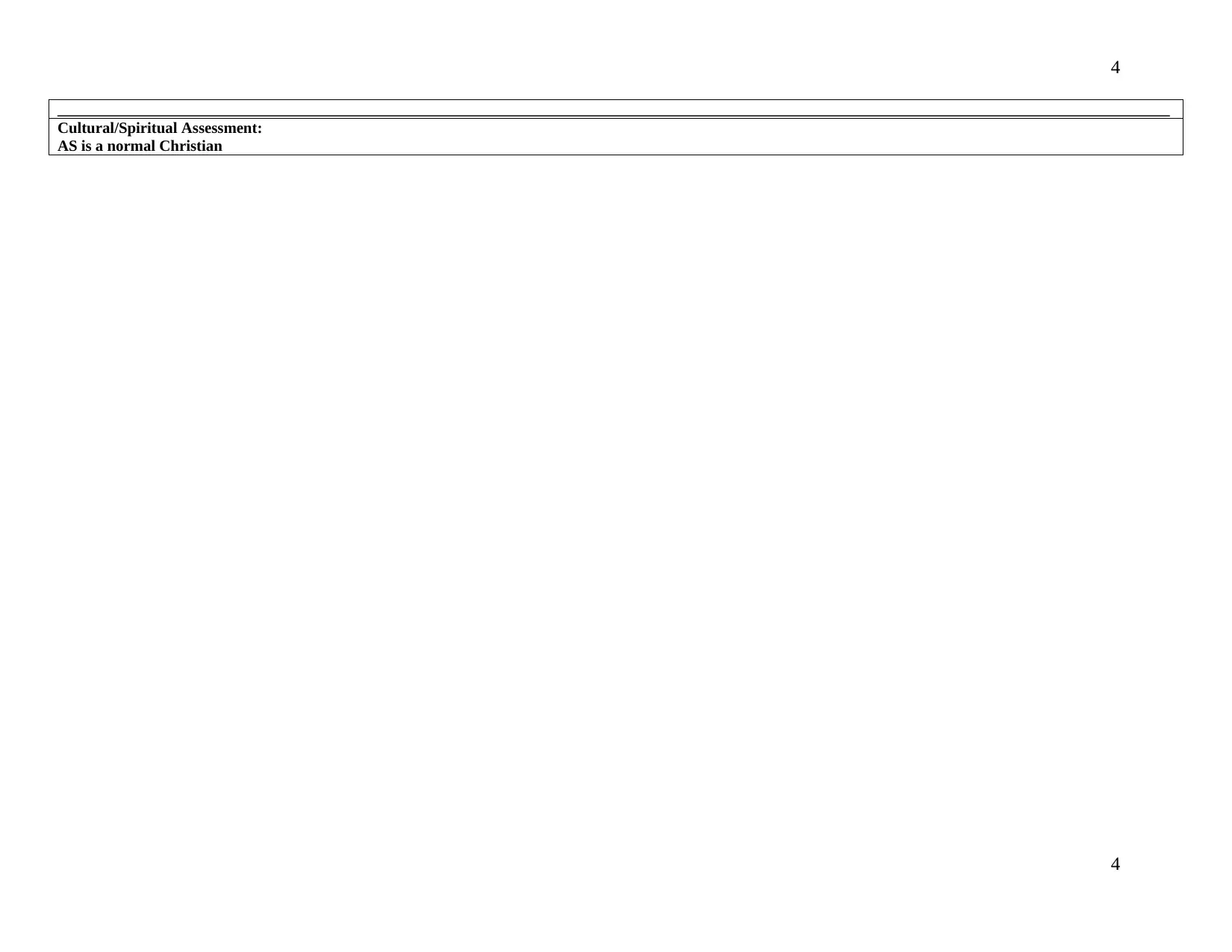
4
_______________________________________________________________________________________________________________________________________________
Cultural/Spiritual Assessment:
AS is a normal Christian
4
_______________________________________________________________________________________________________________________________________________
Cultural/Spiritual Assessment:
AS is a normal Christian
4
Secure Best Marks with AI Grader
Need help grading? Try our AI Grader for instant feedback on your assignments.
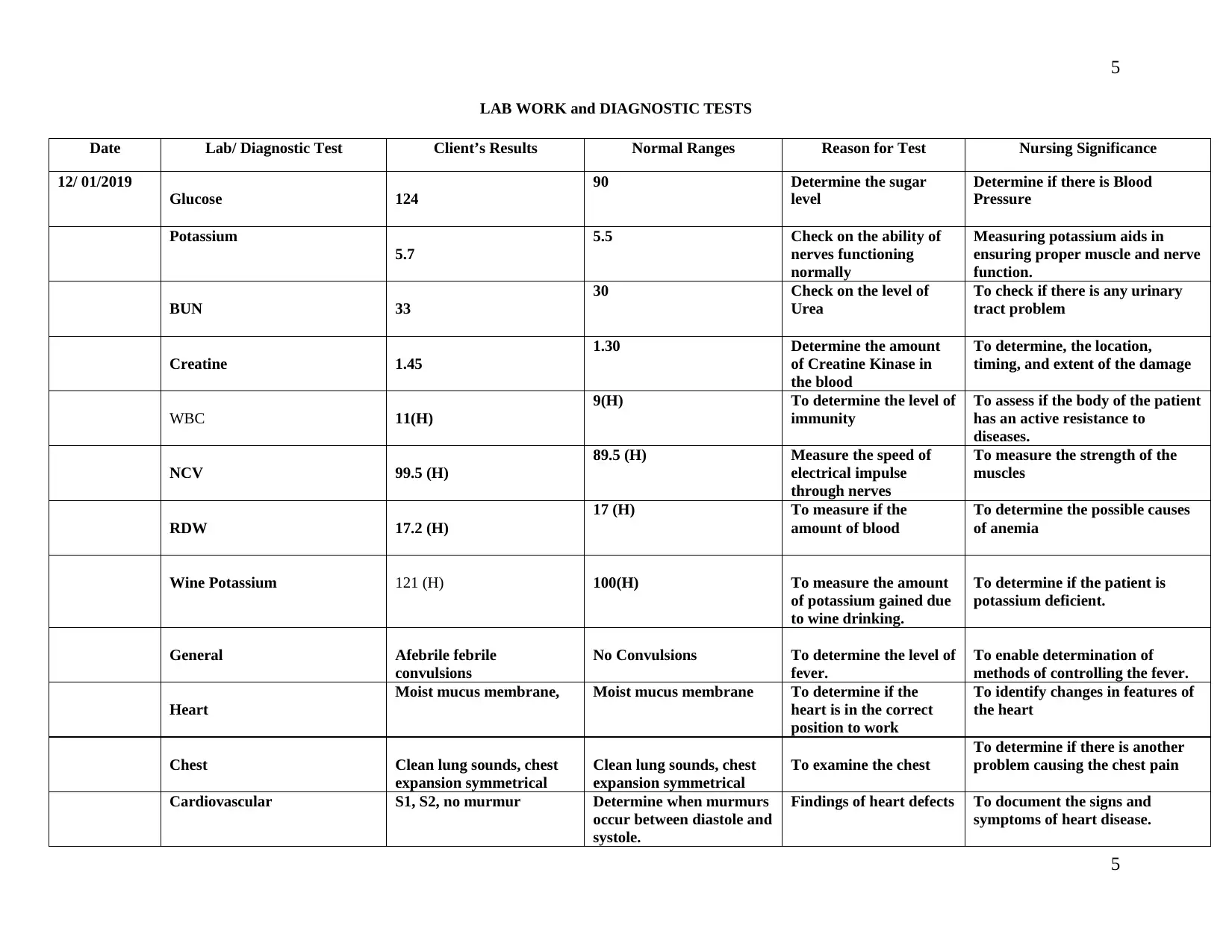
5
LAB WORK and DIAGNOSTIC TESTS
Date Lab/ Diagnostic Test Client’s Results Normal Ranges Reason for Test Nursing Significance
12/ 01/2019
Glucose 124
90 Determine the sugar
level
Determine if there is Blood
Pressure
Potassium
5.7
5.5 Check on the ability of
nerves functioning
normally
Measuring potassium aids in
ensuring proper muscle and nerve
function.
BUN 33
30 Check on the level of
Urea
To check if there is any urinary
tract problem
Creatine 1.45
1.30 Determine the amount
of Creatine Kinase in
the blood
To determine, the location,
timing, and extent of the damage
WBC 11(H)
9(H) To determine the level of
immunity
To assess if the body of the patient
has an active resistance to
diseases.
NCV 99.5 (H)
89.5 (H) Measure the speed of
electrical impulse
through nerves
To measure the strength of the
muscles
RDW 17.2 (H)
17 (H) To measure if the
amount of blood
To determine the possible causes
of anemia
Wine Potassium 121 (H) 100(H) To measure the amount
of potassium gained due
to wine drinking.
To determine if the patient is
potassium deficient.
General Afebrile febrile
convulsions
No Convulsions To determine the level of
fever.
To enable determination of
methods of controlling the fever.
Heart
Moist mucus membrane, Moist mucus membrane To determine if the
heart is in the correct
position to work
To identify changes in features of
the heart
Chest Clean lung sounds, chest
expansion symmetrical
Clean lung sounds, chest
expansion symmetrical
To examine the chest
To determine if there is another
problem causing the chest pain
Cardiovascular S1, S2, no murmur Determine when murmurs
occur between diastole and
systole.
Findings of heart defects To document the signs and
symptoms of heart disease.
5
LAB WORK and DIAGNOSTIC TESTS
Date Lab/ Diagnostic Test Client’s Results Normal Ranges Reason for Test Nursing Significance
12/ 01/2019
Glucose 124
90 Determine the sugar
level
Determine if there is Blood
Pressure
Potassium
5.7
5.5 Check on the ability of
nerves functioning
normally
Measuring potassium aids in
ensuring proper muscle and nerve
function.
BUN 33
30 Check on the level of
Urea
To check if there is any urinary
tract problem
Creatine 1.45
1.30 Determine the amount
of Creatine Kinase in
the blood
To determine, the location,
timing, and extent of the damage
WBC 11(H)
9(H) To determine the level of
immunity
To assess if the body of the patient
has an active resistance to
diseases.
NCV 99.5 (H)
89.5 (H) Measure the speed of
electrical impulse
through nerves
To measure the strength of the
muscles
RDW 17.2 (H)
17 (H) To measure if the
amount of blood
To determine the possible causes
of anemia
Wine Potassium 121 (H) 100(H) To measure the amount
of potassium gained due
to wine drinking.
To determine if the patient is
potassium deficient.
General Afebrile febrile
convulsions
No Convulsions To determine the level of
fever.
To enable determination of
methods of controlling the fever.
Heart
Moist mucus membrane, Moist mucus membrane To determine if the
heart is in the correct
position to work
To identify changes in features of
the heart
Chest Clean lung sounds, chest
expansion symmetrical
Clean lung sounds, chest
expansion symmetrical
To examine the chest
To determine if there is another
problem causing the chest pain
Cardiovascular S1, S2, no murmur Determine when murmurs
occur between diastole and
systole.
Findings of heart defects To document the signs and
symptoms of heart disease.
5
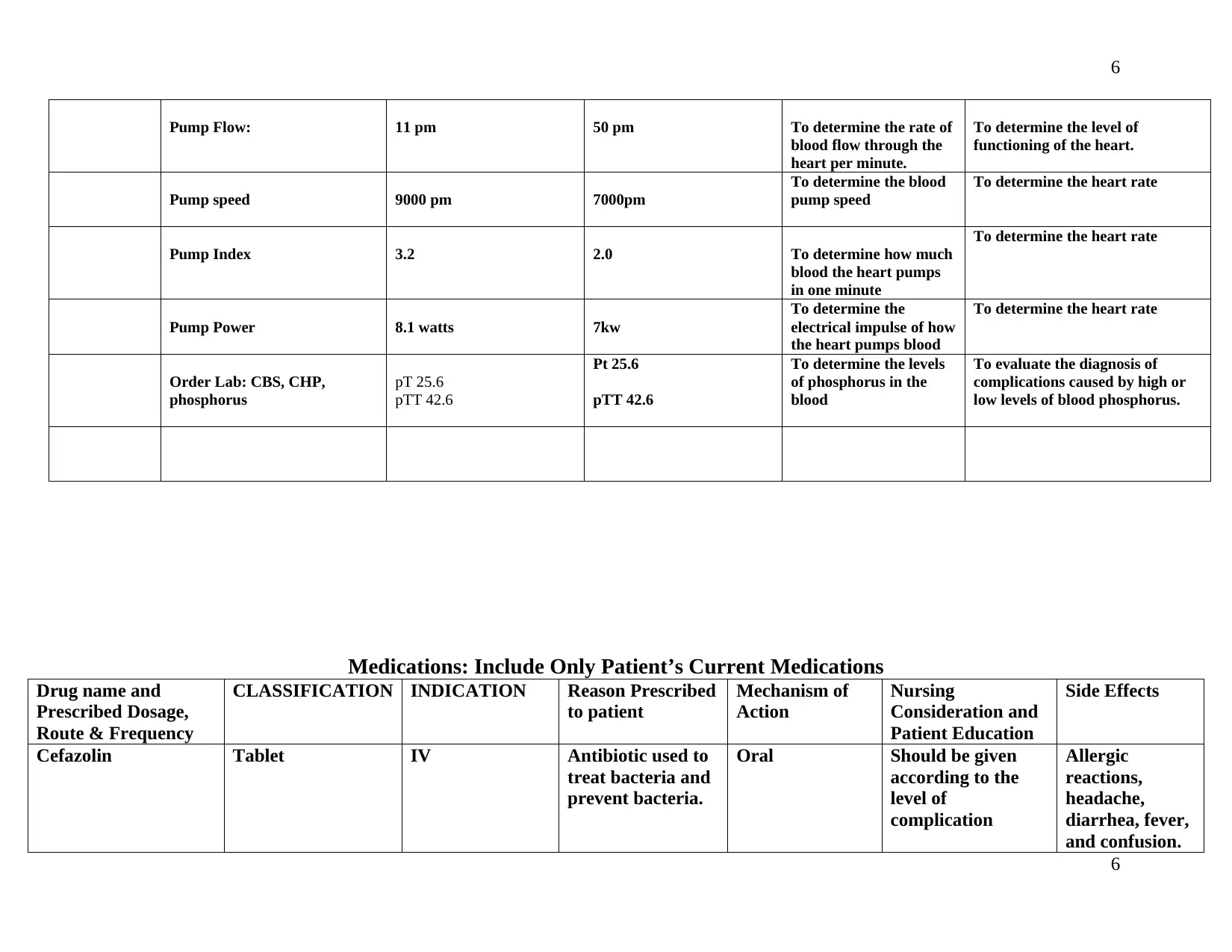
6
Pump Flow: 11 pm 50 pm To determine the rate of
blood flow through the
heart per minute.
To determine the level of
functioning of the heart.
Pump speed 9000 pm 7000pm
To determine the blood
pump speed
To determine the heart rate
Pump Index 3.2 2.0 To determine how much
blood the heart pumps
in one minute
To determine the heart rate
Pump Power 8.1 watts 7kw
To determine the
electrical impulse of how
the heart pumps blood
To determine the heart rate
Order Lab: CBS, CHP,
phosphorus
pT 25.6
pTT 42.6
Pt 25.6
pTT 42.6
To determine the levels
of phosphorus in the
blood
To evaluate the diagnosis of
complications caused by high or
low levels of blood phosphorus.
Medications: Include Only Patient’s Current Medications
Drug name and
Prescribed Dosage,
Route & Frequency
CLASSIFICATION INDICATION Reason Prescribed
to patient
Mechanism of
Action
Nursing
Consideration and
Patient Education
Side Effects
Cefazolin Tablet IV Antibiotic used to
treat bacteria and
prevent bacteria.
Oral Should be given
according to the
level of
complication
Allergic
reactions,
headache,
diarrhea, fever,
and confusion.
6
Pump Flow: 11 pm 50 pm To determine the rate of
blood flow through the
heart per minute.
To determine the level of
functioning of the heart.
Pump speed 9000 pm 7000pm
To determine the blood
pump speed
To determine the heart rate
Pump Index 3.2 2.0 To determine how much
blood the heart pumps
in one minute
To determine the heart rate
Pump Power 8.1 watts 7kw
To determine the
electrical impulse of how
the heart pumps blood
To determine the heart rate
Order Lab: CBS, CHP,
phosphorus
pT 25.6
pTT 42.6
Pt 25.6
pTT 42.6
To determine the levels
of phosphorus in the
blood
To evaluate the diagnosis of
complications caused by high or
low levels of blood phosphorus.
Medications: Include Only Patient’s Current Medications
Drug name and
Prescribed Dosage,
Route & Frequency
CLASSIFICATION INDICATION Reason Prescribed
to patient
Mechanism of
Action
Nursing
Consideration and
Patient Education
Side Effects
Cefazolin Tablet IV Antibiotic used to
treat bacteria and
prevent bacteria.
Oral Should be given
according to the
level of
complication
Allergic
reactions,
headache,
diarrhea, fever,
and confusion.
6
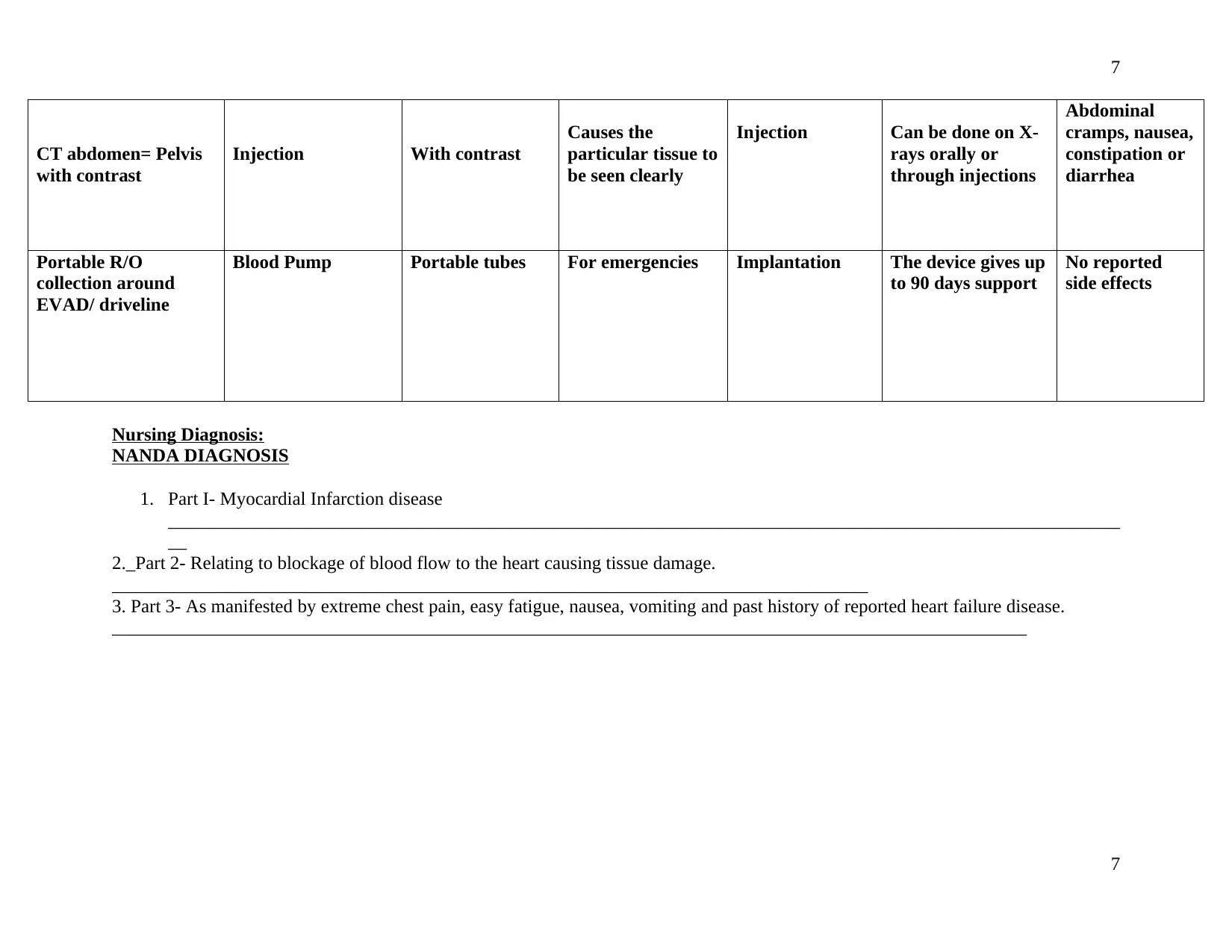
7
CT abdomen= Pelvis
with contrast
Injection With contrast
Causes the
particular tissue to
be seen clearly
Injection Can be done on X-
rays orally or
through injections
Abdominal
cramps, nausea,
constipation or
diarrhea
Portable R/O
collection around
EVAD/ driveline
Blood Pump Portable tubes For emergencies Implantation The device gives up
to 90 days support
No reported
side effects
Nursing Diagnosis:
NANDA DIAGNOSIS
1. Part I- Myocardial Infarction disease
______________________________________________________________________________________________________
__
2._Part 2- Relating to blockage of blood flow to the heart causing tissue damage.
_________________________________________________________________________________
3. Part 3- As manifested by extreme chest pain, easy fatigue, nausea, vomiting and past history of reported heart failure disease.
__________________________________________________________________________________________________
7
CT abdomen= Pelvis
with contrast
Injection With contrast
Causes the
particular tissue to
be seen clearly
Injection Can be done on X-
rays orally or
through injections
Abdominal
cramps, nausea,
constipation or
diarrhea
Portable R/O
collection around
EVAD/ driveline
Blood Pump Portable tubes For emergencies Implantation The device gives up
to 90 days support
No reported
side effects
Nursing Diagnosis:
NANDA DIAGNOSIS
1. Part I- Myocardial Infarction disease
______________________________________________________________________________________________________
__
2._Part 2- Relating to blockage of blood flow to the heart causing tissue damage.
_________________________________________________________________________________
3. Part 3- As manifested by extreme chest pain, easy fatigue, nausea, vomiting and past history of reported heart failure disease.
__________________________________________________________________________________________________
7
Paraphrase This Document
Need a fresh take? Get an instant paraphrase of this document with our AI Paraphraser

8
SUPPORTIVE DATA
Assessment
Nursing diagnosis PLAN/EXPECTED
OUTCOMES
INTERVENTIONS RATIONALES &
REFERENCES
EVALU
Subjective Data
The patient complains of
extreme chest pain. He
states that ‘” I hardly sleep
because of the
excruciating chest pain
and I cannot do a slight
activity. He reports
several cases of extreme
fever.
Objective Data
Weight = 62 Kg
Fever at 39.0 degrees
Celsius
Chest pain at nine on a
scale of 0-10.
Pain(Park, 2014)
related underlying
myocardial infarction
as evident by extreme
chest pain radiating
from left arm towards
the jaw.
1. The client will able to
rest comfortably and
move without shortness in
breath.
2. The patient will not
experience the chest pain
As evidenced by;
3.Taking the administered
medications.
4. The ability to use
emergency medications in
case of an unexpected
occurrence of chest pains.
5. reduce pain to a scale
of 3 by the end of 2 hours
.
1. The nurse should
study the features
of chest pain,
including the
duration, quality,
intensity,
location,
radiations, and
other impulsive
factors.
2. The nurse should
assess the
respiration rate,
the level of blood
pressure and
record every
episode of pain.
3. The nurse will
document the
history of ay past
cardiac problems
or historic family
cardiac issues.
4. Administer the
patient with the
appropriate
medications and
monitor their
1. Chest pain is a
symptom of
Myocardial Infarction
and aids in giving the
quantity of the pain
which helps in
differentiating current
and preexisting
patterns and also
identify complications.
2. Respiration rate
may increase due to
anxiety and cases of
pain (Urden, Stacy &
Lough, 2017)
3. Obtaining
information from
parents or the patient
gives vital data for
differentiating current
pain from past
complications
(Swallow, Webb &
Smith,2015).
4. Controlling pain
should be a priority
since it indicates
Within one hour of
the patient regained
able to rest comfort
stated a decrease in
The expected outco
ability to rest is ach
The goal of regaini
feeling of control is
patient stated that h
well.
The patient can mov
reduced fatigue.
8
SUPPORTIVE DATA
Assessment
Nursing diagnosis PLAN/EXPECTED
OUTCOMES
INTERVENTIONS RATIONALES &
REFERENCES
EVALU
Subjective Data
The patient complains of
extreme chest pain. He
states that ‘” I hardly sleep
because of the
excruciating chest pain
and I cannot do a slight
activity. He reports
several cases of extreme
fever.
Objective Data
Weight = 62 Kg
Fever at 39.0 degrees
Celsius
Chest pain at nine on a
scale of 0-10.
Pain(Park, 2014)
related underlying
myocardial infarction
as evident by extreme
chest pain radiating
from left arm towards
the jaw.
1. The client will able to
rest comfortably and
move without shortness in
breath.
2. The patient will not
experience the chest pain
As evidenced by;
3.Taking the administered
medications.
4. The ability to use
emergency medications in
case of an unexpected
occurrence of chest pains.
5. reduce pain to a scale
of 3 by the end of 2 hours
.
1. The nurse should
study the features
of chest pain,
including the
duration, quality,
intensity,
location,
radiations, and
other impulsive
factors.
2. The nurse should
assess the
respiration rate,
the level of blood
pressure and
record every
episode of pain.
3. The nurse will
document the
history of ay past
cardiac problems
or historic family
cardiac issues.
4. Administer the
patient with the
appropriate
medications and
monitor their
1. Chest pain is a
symptom of
Myocardial Infarction
and aids in giving the
quantity of the pain
which helps in
differentiating current
and preexisting
patterns and also
identify complications.
2. Respiration rate
may increase due to
anxiety and cases of
pain (Urden, Stacy &
Lough, 2017)
3. Obtaining
information from
parents or the patient
gives vital data for
differentiating current
pain from past
complications
(Swallow, Webb &
Smith,2015).
4. Controlling pain
should be a priority
since it indicates
Within one hour of
the patient regained
able to rest comfort
stated a decrease in
The expected outco
ability to rest is ach
The goal of regaini
feeling of control is
patient stated that h
well.
The patient can mov
reduced fatigue.
8

9
trends during
drug
administration
5. Notify the doctor
when pain does
not reduce.
6. Instruct and
counsel the
patients on the
limitations after
hospitalization
7. Instruct the
patient or family
on the side effects
of the prescribed
medicine
ischemia (Lee,2015).
5. To aid in pain
control in extreme
cases.
6. To provide
knowledge of
therapeutic
routines.
7. To inform
them on the
therapeutic
drug regimen
to avoid
mistakes which
could worsen
the
complication.
References
Lee, T. T. (2015). Nurses’ concerns about using information systems: analysis of comments on a computerized nursing care plan
system in Taiwan. Journal of Clinical Nursing, 14(3), 344-353.
9
trends during
drug
administration
5. Notify the doctor
when pain does
not reduce.
6. Instruct and
counsel the
patients on the
limitations after
hospitalization
7. Instruct the
patient or family
on the side effects
of the prescribed
medicine
ischemia (Lee,2015).
5. To aid in pain
control in extreme
cases.
6. To provide
knowledge of
therapeutic
routines.
7. To inform
them on the
therapeutic
drug regimen
to avoid
mistakes which
could worsen
the
complication.
References
Lee, T. T. (2015). Nurses’ concerns about using information systems: analysis of comments on a computerized nursing care plan
system in Taiwan. Journal of Clinical Nursing, 14(3), 344-353.
9
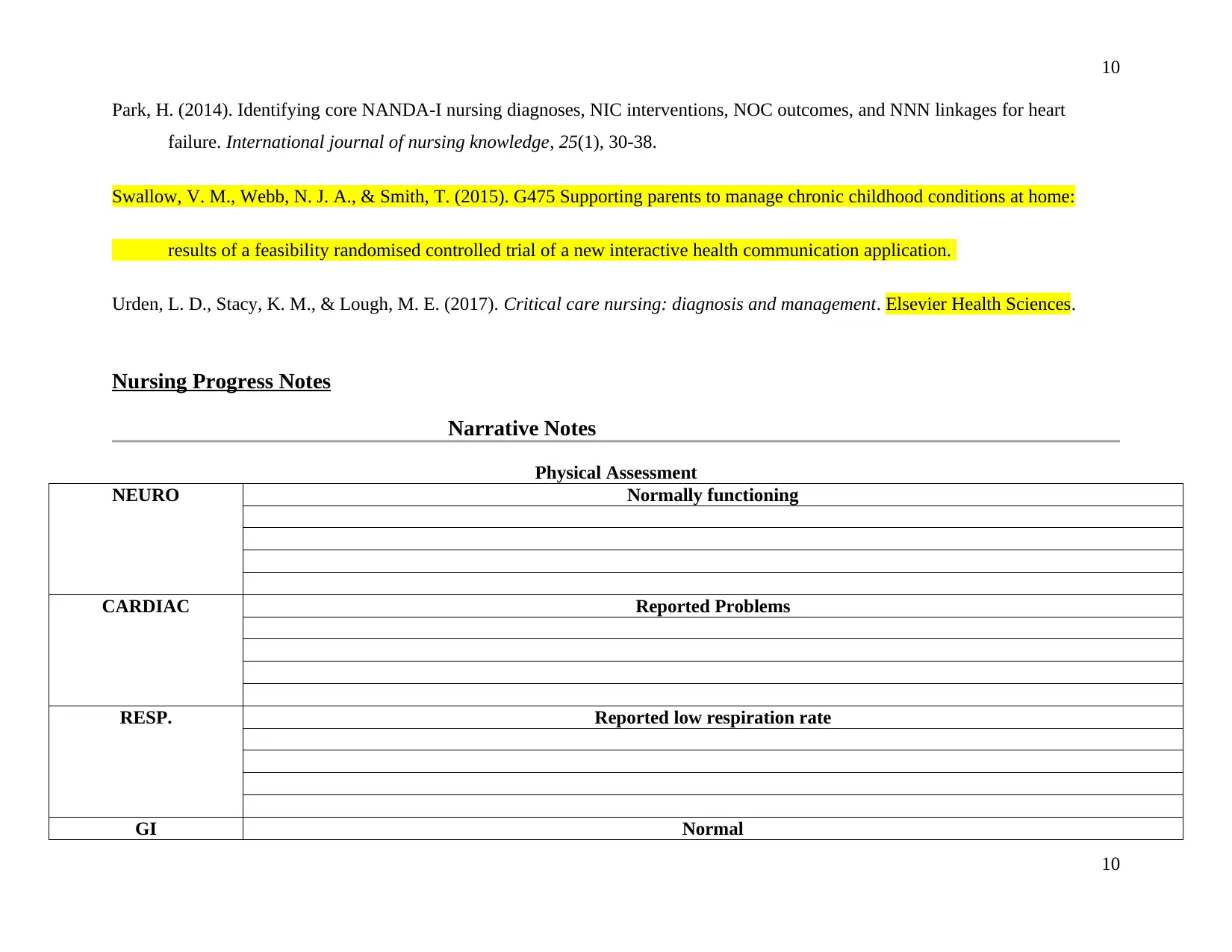
10
Park, H. (2014). Identifying core NANDA‐I nursing diagnoses, NIC interventions, NOC outcomes, and NNN linkages for heart
failure. International journal of nursing knowledge, 25(1), 30-38.
Swallow, V. M., Webb, N. J. A., & Smith, T. (2015). G475 Supporting parents to manage chronic childhood conditions at home:
results of a feasibility randomised controlled trial of a new interactive health communication application.
Urden, L. D., Stacy, K. M., & Lough, M. E. (2017). Critical care nursing: diagnosis and management. Elsevier Health Sciences.
Nursing Progress Notes
Narrative Notes
Physical Assessment
NEURO Normally functioning
CARDIAC Reported Problems
RESP. Reported low respiration rate
GI Normal
10
Park, H. (2014). Identifying core NANDA‐I nursing diagnoses, NIC interventions, NOC outcomes, and NNN linkages for heart
failure. International journal of nursing knowledge, 25(1), 30-38.
Swallow, V. M., Webb, N. J. A., & Smith, T. (2015). G475 Supporting parents to manage chronic childhood conditions at home:
results of a feasibility randomised controlled trial of a new interactive health communication application.
Urden, L. D., Stacy, K. M., & Lough, M. E. (2017). Critical care nursing: diagnosis and management. Elsevier Health Sciences.
Nursing Progress Notes
Narrative Notes
Physical Assessment
NEURO Normally functioning
CARDIAC Reported Problems
RESP. Reported low respiration rate
GI Normal
10
Secure Best Marks with AI Grader
Need help grading? Try our AI Grader for instant feedback on your assignments.
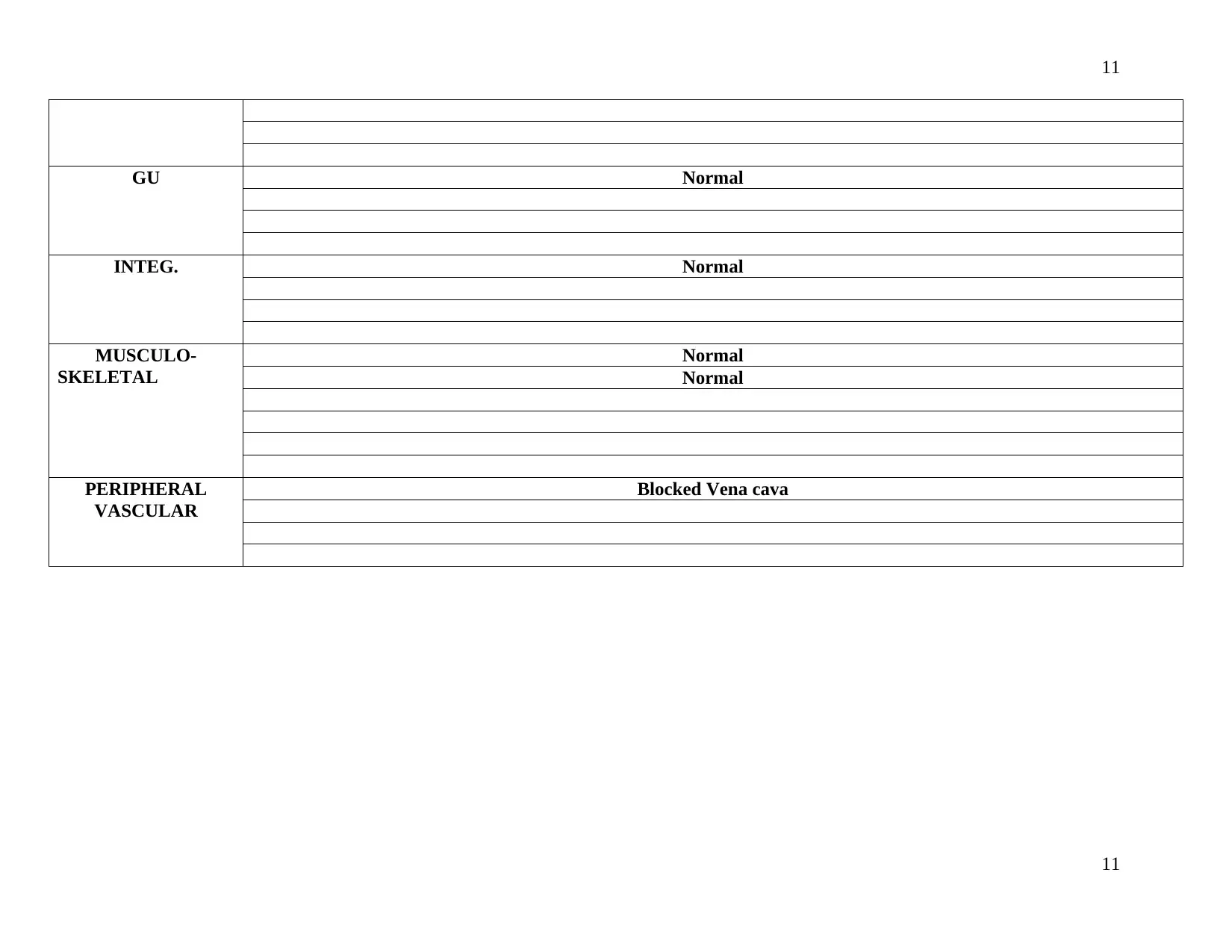
11
GU Normal
INTEG. Normal
MUSCULO-
SKELETAL
Normal
Normal
PERIPHERAL
VASCULAR
Blocked Vena cava
11
GU Normal
INTEG. Normal
MUSCULO-
SKELETAL
Normal
Normal
PERIPHERAL
VASCULAR
Blocked Vena cava
11
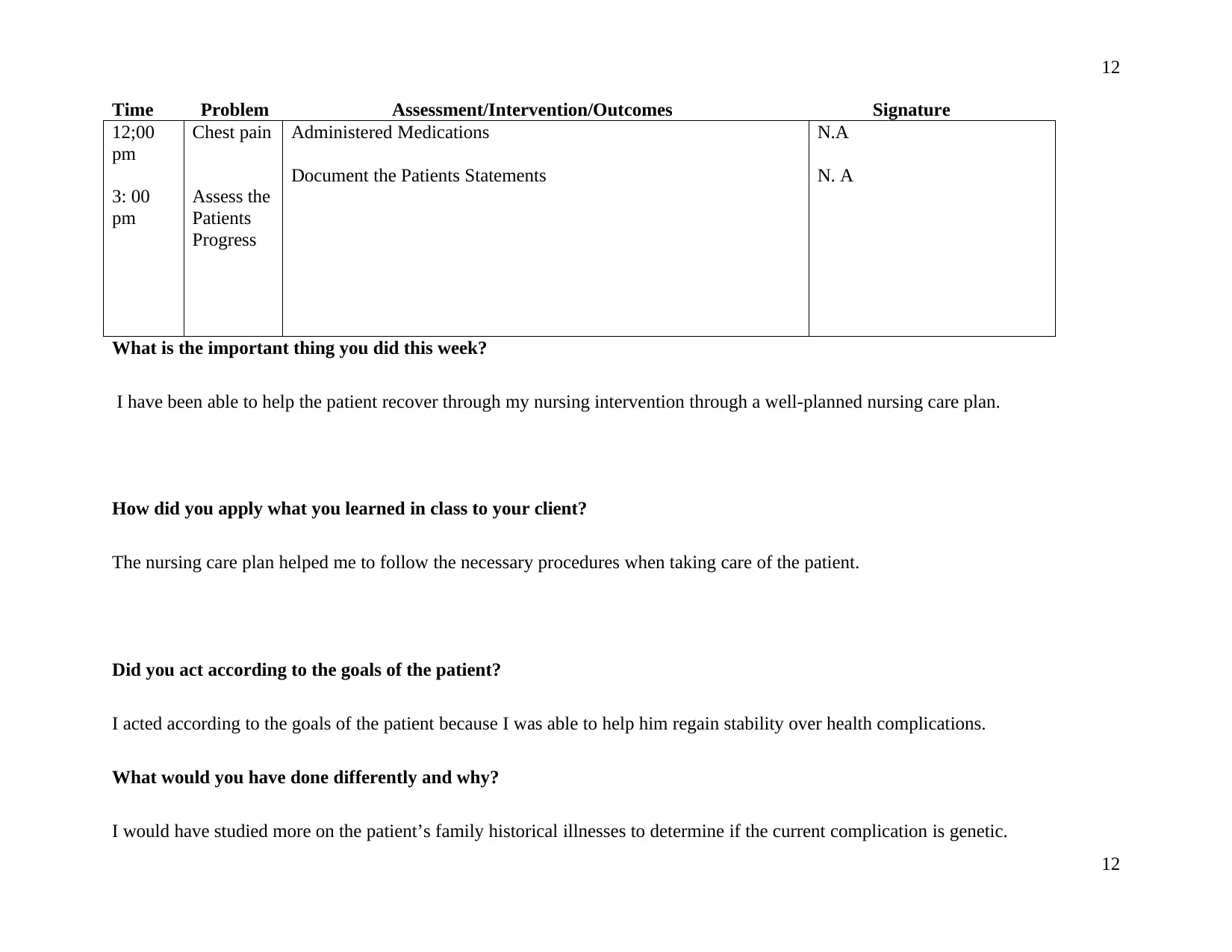
12
Time Problem Assessment/Intervention/Outcomes Signature
12;00
pm
3: 00
pm
Chest pain
Assess the
Patients
Progress
Administered Medications
Document the Patients Statements
N.A
N. A
What is the important thing you did this week?
I have been able to help the patient recover through my nursing intervention through a well-planned nursing care plan.
How did you apply what you learned in class to your client?
The nursing care plan helped me to follow the necessary procedures when taking care of the patient.
Did you act according to the goals of the patient?
I acted according to the goals of the patient because I was able to help him regain stability over health complications.
What would you have done differently and why?
I would have studied more on the patient’s family historical illnesses to determine if the current complication is genetic.
12
Time Problem Assessment/Intervention/Outcomes Signature
12;00
pm
3: 00
pm
Chest pain
Assess the
Patients
Progress
Administered Medications
Document the Patients Statements
N.A
N. A
What is the important thing you did this week?
I have been able to help the patient recover through my nursing intervention through a well-planned nursing care plan.
How did you apply what you learned in class to your client?
The nursing care plan helped me to follow the necessary procedures when taking care of the patient.
Did you act according to the goals of the patient?
I acted according to the goals of the patient because I was able to help him regain stability over health complications.
What would you have done differently and why?
I would have studied more on the patient’s family historical illnesses to determine if the current complication is genetic.
12

13
13
13
1 out of 13
Related Documents
Your All-in-One AI-Powered Toolkit for Academic Success.
+13062052269
info@desklib.com
Available 24*7 on WhatsApp / Email
![[object Object]](/_next/static/media/star-bottom.7253800d.svg)
Unlock your academic potential
© 2024 | Zucol Services PVT LTD | All rights reserved.





